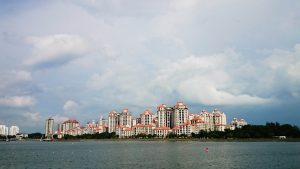Naming as styling: Inauthenticity in building names in Singapore
May 24, 2022

Names are deliberate choices which reflect the particular preferences of the communities they belong to, and are a significant part of culture. In modern societies, the act of naming frequently involves a process of formal registration and can be accompanied by a christening ceremony, making the act of naming and the names themselves all the more culturally significant.
Buildings in Singapore have to follow guidelines set by the Street and Building Names Board, which highlight the need for names to reflect the true identity of the place. These guidelines include fitting the location, environment, size and type of the development, as well as retaining the history of the building or area.
Condominium names in Singapore have often attracted complaints. For instance, The Levelz, a condominium completed on 24 May 2005, along with other condominiums like D’Zire, Thr3e Thre3 Robin and L’viv were called “funny, bizarre, or just downright facepalm-worthy” in a recent article published on AsiaOne.
In ‘Naming as styling: Inauthenticity in building names in Singapore’ (in Language in Place: Stylistic perspectives on landscape, place and environment (2021)), Dr Peter K. W. Tan (NUS Department of English Language and Literature) examines condominium names as representing meaningful choices made by developers, and how ‘authentic’ these names are perceived to be.
Earlier building names generally consisted of a generic and specific element. The generic element, also called a classifier, describes the kind of entity that the name refers to (Mansions, Apartment, Residences), while the specific element is what distinguishes between buildings and is often derived from the street. Building names were dominantly in English, but other official and non-official languages were also represented. One example is Eng Hoon Mansions, which includes a Hokkien specific element. From a historical point of view, the use of Hokkien in the names makes them more authentic because the original Chinese immigrants of Singapore were mainly Hokkien speakers.
In newer buildings, the generic element is sometimes abandoned. English-based and Romance languages (such as French, Italian, and Spanish) are increasingly represented, and made-up names have also started to appear more often. Dr Tan acknowledges that there may be valid commercial reasons for wanting to signal foreignness – developers may argue that the homes they build represent an escape from the mundane, and symbolise an ambience or aspiration, rather than the environment itself. Breaking out of the traditional mould also tends to be perceived as fashionable, and gives the name a “cool” quotient.
There have also been complaints about developers showing illiteracy by using French-looking and sounding elements in ways that are not possible in French, such as in the condominium name D’Weave. These condominium names are also regarded as inauthentic because they deliberately ignore the conventional spellings established by society. Invented names such as “Vogx” are described to be devoid of sense and unable to symbolise the local environment.
However, Dr Tan explains that these names may be symbolising a more cosmopolitan and outward-looking perspective. Though there is a contestation between the modernist and postmodernist perspectives on the naming of residential buildings, the flip side to the “authentic name” may not necessarily be the “inauthentic name”. One person’s “cool” is another person’s “inauthentic”. Rather than focusing on the traditional narrative, modern developers may instead choose to present a more aesthetic, playful sensibility when naming condominiums.
Read the article here.
